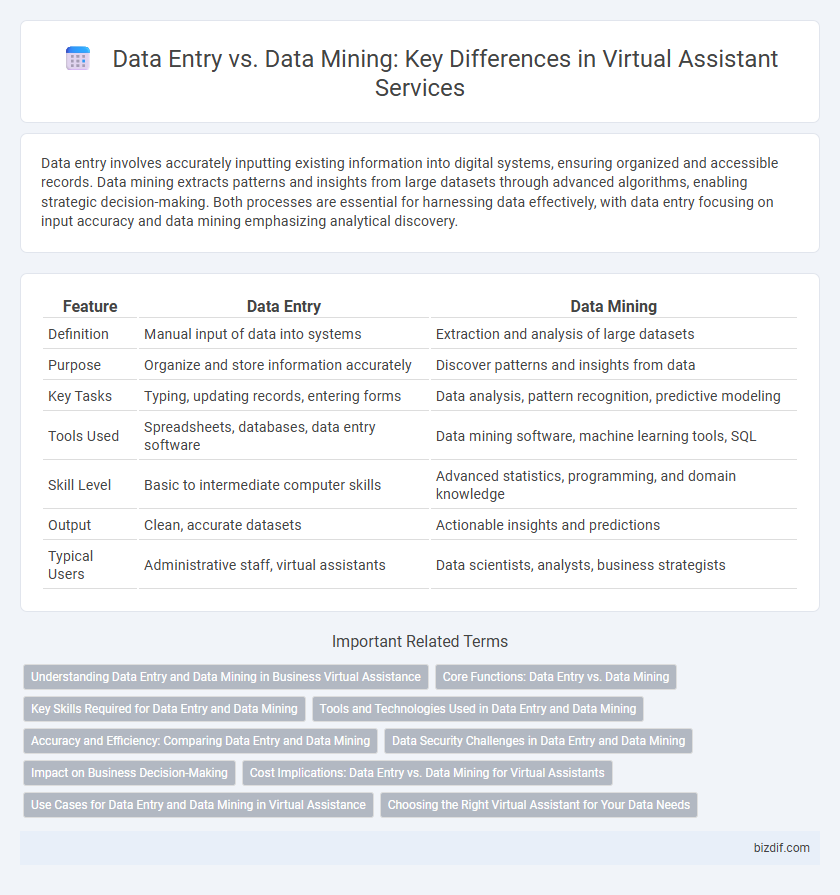Data entry involves accurately inputting existing information into digital systems, ensuring organized and accessible records. Data mining extracts patterns and insights from large datasets through advanced algorithms, enabling strategic decision-making. Both processes are essential for harnessing data effectively, with data entry focusing on input accuracy and data mining emphasizing analytical discovery.
Table of Comparison
| Feature | Data Entry | Data Mining |
|---|---|---|
| Definition | Manual input of data into systems | Extraction and analysis of large datasets |
| Purpose | Organize and store information accurately | Discover patterns and insights from data |
| Key Tasks | Typing, updating records, entering forms | Data analysis, pattern recognition, predictive modeling |
| Tools Used | Spreadsheets, databases, data entry software | Data mining software, machine learning tools, SQL |
| Skill Level | Basic to intermediate computer skills | Advanced statistics, programming, and domain knowledge |
| Output | Clean, accurate datasets | Actionable insights and predictions |
| Typical Users | Administrative staff, virtual assistants | Data scientists, analysts, business strategists |
Understanding Data Entry and Data Mining in Business Virtual Assistance
Data entry in business virtual assistance involves accurately inputting and managing structured information, ensuring organized records and seamless workflow integration. Data mining goes deeper, extracting valuable patterns and insights from large datasets to inform strategic decisions and optimize operations. Mastery of both enables virtual assistants to support businesses efficiently by maintaining data integrity while uncovering actionable intelligence.
Core Functions: Data Entry vs. Data Mining
Data entry involves accurately inputting and updating information into databases or systems, emphasizing precision and consistency in handling structured data. Data mining focuses on analyzing large datasets to discover patterns, trends, and insights, utilizing statistical models and machine learning algorithms. Core functions of data entry prioritize speed and error reduction, while data mining centers on extracting valuable knowledge from complex data sources.
Key Skills Required for Data Entry and Data Mining
Data entry requires proficiency in typing speed, accuracy, attention to detail, and familiarity with database software to efficiently input and manage information. Data mining demands strong analytical skills, expertise in statistical analysis, programming languages like Python or R, and the ability to interpret complex datasets to uncover patterns and insights. Both fields benefit from critical thinking and problem-solving abilities, but data mining emphasizes advanced technical knowledge and data manipulation.
Tools and Technologies Used in Data Entry and Data Mining
Data entry relies heavily on tools like Microsoft Excel, Google Sheets, and Optical Character Recognition (OCR) software to efficiently input and organize information. Data mining utilizes advanced technologies such as Python libraries (Pandas, Scikit-learn), SQL databases, and machine learning algorithms to analyze large datasets and extract meaningful patterns. Both processes benefit from automation tools like Robotic Process Automation (RPA) to improve accuracy and speed in handling data.
Accuracy and Efficiency: Comparing Data Entry and Data Mining
Data entry emphasizes accuracy by manually inputting information, ensuring precision but often requiring more time and effort. Data mining leverages automated algorithms to extract and analyze large datasets rapidly, significantly enhancing efficiency while maintaining accuracy through sophisticated validation techniques. Balancing these approaches allows virtual assistants to optimize both data quality and workflow speed in various applications.
Data Security Challenges in Data Entry and Data Mining
Data security challenges in data entry primarily involve unauthorized access, data breaches, and human errors during manual input, which can compromise sensitive information. In contrast, data mining faces risks related to the extraction of protected data from large datasets without proper anonymization, potentially exposing confidential patterns and personal details. Both processes require robust encryption, access controls, and continuous monitoring to ensure the integrity and confidentiality of the data handled by virtual assistants.
Impact on Business Decision-Making
Data entry ensures accurate and organized input of business information, enabling reliable record-keeping and seamless operational workflows. Data mining uncovers hidden patterns and trends from large datasets, providing actionable insights that drive strategic decision-making. Together, these processes enhance data quality and analytical depth, empowering businesses to make informed, data-driven decisions that improve performance and competitiveness.
Cost Implications: Data Entry vs. Data Mining for Virtual Assistants
Data entry for virtual assistants typically involves repetitive input tasks that require less specialized skills and lower operational costs, making it more budget-friendly for routine projects. In contrast, data mining demands advanced analytical tools and expertise to extract valuable insights from large datasets, resulting in higher expenses related to software, training, and computational resources. Choosing between data entry and data mining depends on the project's budget constraints and the complexity of data processing required to support informed decision-making.
Use Cases for Data Entry and Data Mining in Virtual Assistance
Data entry in virtual assistance involves accurately inputting, organizing, and updating information such as customer records, appointment schedules, and transaction details to ensure seamless business operations. Data mining enables virtual assistants to analyze large datasets for patterns, customer behavior insights, and market trends, enhancing decision-making and personalized service delivery. Use cases for data entry include maintaining CRM databases and processing orders, while data mining supports lead generation, sentiment analysis, and predictive analytics within virtual assistant tasks.
Choosing the Right Virtual Assistant for Your Data Needs
Data entry involves accurately inputting and organizing existing information, while data mining focuses on analyzing large datasets to extract meaningful patterns and insights. Choosing the right virtual assistant depends on your specific needs: opt for data entry specialists for tasks requiring precision and speed in handling structured data, and select data mining experts for complex analysis, trend identification, and decision support. Evaluating the virtual assistant's expertise in relevant tools like Excel, SQL, or Python ensures optimal results for your data-driven projects.
Data entry vs Data mining Infographic

 bizdif.com
bizdif.com